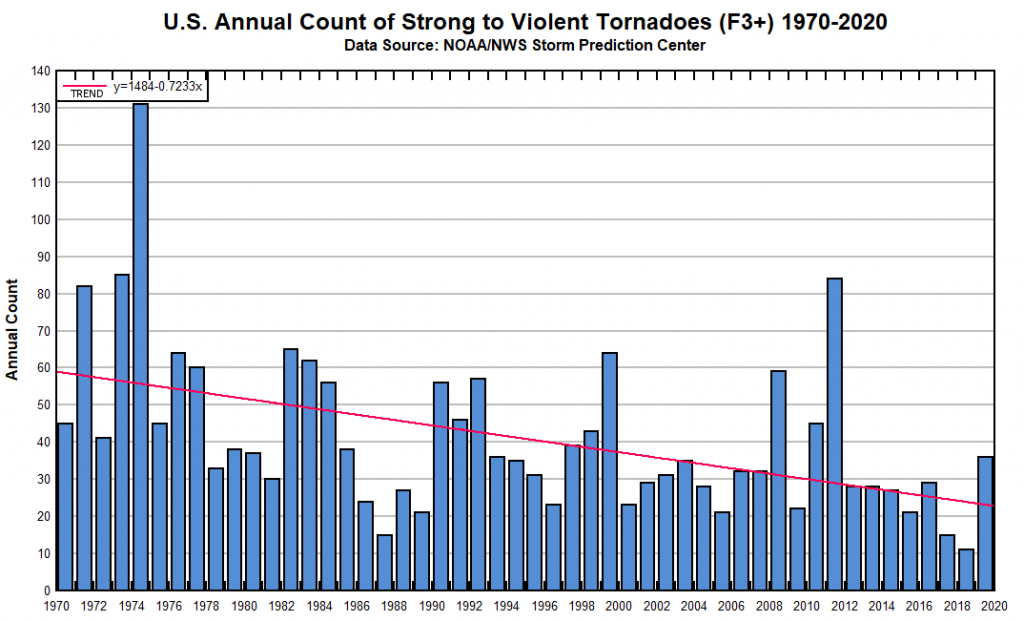In the aftermath of the terrible, deadly multiple tornado strikes across Arkansas, Illinois, Kentucky, Missouri, and Tennessee on December 10, President Joe Biden wasted no time in linking the recent tornado disaster in Kentucky to climate change.
During his Saturday morning media briefing discussing the tragedy, Biden responded to a question asking if the time and severity of the tornadoes were due to climate change saying:
Well, all that I know is that the intensity of the weather across the board has some impact as a consequence of the warming of the planet and the climate change…
The specific impact on these specific storms, I can’t say at this point. I’m going to be asking the EPA and others to take a look at that. But the fact is that we all know everything is more intense when the climate is warming — everything. And, obviously, it has some impact here, but I can’t give you a — a quantitative read on that.
Biden is wrong on both counts. In its recent Sixth Assessment Report the U.N. Intergovernmental Panel on Climate Change finds no evidence the majority of weather events are becoming more extreme, including tornados. As detailed in a post by the University of Colorado’s Roger Pielke Jr, “it is simply incorrect to claim that on climate time scales the frequency or intensity of extreme weather and climate events has increased for: flooding, drought (meteorological or hydrological), tropical cyclones, winter storms, thunderstorms, tornadoes, hail, lightning or extreme winds (so, storms of any type).”
Concerning tornadoes, in particular, the IPCC states, “There is low confidence in observed trends in small spatial-scale phenomena such as tornadoes.”
Tornadoes in December are not unheard of. In 2015, on December 26, 27, and 28 a weather front produced multiple tornadoes across a wide swath of the Southern United States, but centered mostly in North Texas. On December 26, 32 tornadoes of various strengths struck North Texas. One tornado, an EF4 struck very near my home in Rowlett, Texas, destroying more than 400 homes and 22 businesses, injuring more than 400 people, and killing 10. On December 5, 1953, during a period when the earth was in entering a cooling trend, an F5 tornado devastated Vicksburg, Mississippi killing 38. Also on December 18, 1957, an F5 tornado struck Sunfield, Illinois killing 13, as part of a 3 day series of tornado strikes across the South and Mid-West.
As discussed in Climate at a Glance: Tornadoes, the number of tornadoes has been declining for the past 50 years, and, as shown in the figure below, the number of strong tornadoes, F3 or higher, has been dramatically declining for the past 50 years.

From 2017 through 2018, the U.S. set a record for the longest period in history without a tornado death. Also in 2017 and 2018, the U.S. set a record for the longest period in history without an F3 or stronger tornado. The two record-low years for number of tornadoes both occurred this past decade, in 2014 and 2018. Even counting the recent December tornadoes, the number of tornados recorded in 2021 was below average.
In short, contrary to any claims by Biden or his FEMA head, Deanne Criswell, that deadly tornado strikes and extreme weather are the “new normal,” due to climate change, there is no evidence climate change caused or enhanced the December 10, tornado strikes in the United States, or that extreme weather events are becoming more common.
For Criswell to claim, as she did that, “at this magnitude, I don’t think we have ever seen one this late in the year,” shows how woefully misinformed she is.
Rather than trying to promote their climate change policies by “not letting a disaster go to waste,” to paraphrase Democratic operative Rahm Emanuel’s famous dictum, they should do their jobs and provide comfort and aide to the people suffering in the aftermath of these storms. That’s the moral choice.





















Please expand on the following:
This article has a NOAA graph showing annual Tornado reporting.
Today’s (12/14) BBC News, also shows a NOAA graph showing the same name data: https://www.bbc.com/news/59641376 .
These data sets seem to be in direct opposition with each other!
OK, who’s cooking the books?
Thanks, Jim L
That graph at BBC is ALL tornadoes, and there is a reporting bias due to increased media coverge, increased population, more cell phone cameras, doppler radar, etc. This bias shows up in smaller tornadoes, previously missed in the 50’s 60’s
From the BBC article:
As data-collecting methods have improved, less severe tornadoes have been recorded more consistently.
“To an untrained eye, it may look like we are having more of these events happening – but in reality what is happening is we have much better tools for identifying relatively weaker tornadoes,” Dr Jana Houser, professor of meteorology, at the University of Ohio, says.
Our graph shows EF3 or greater tornadoes….the severe ones.